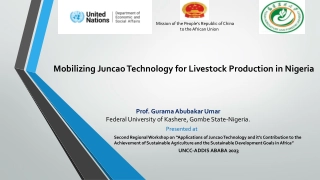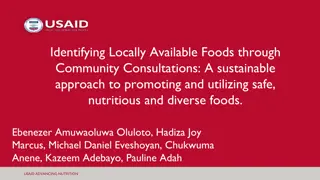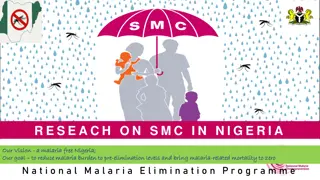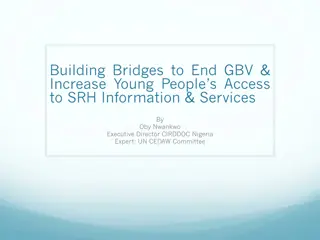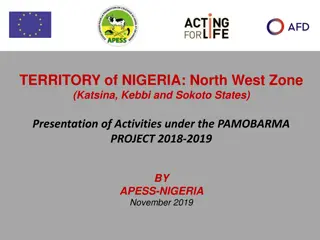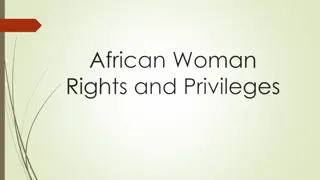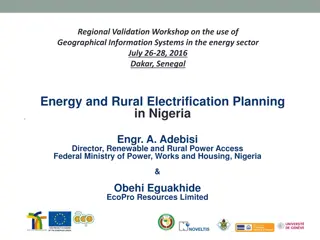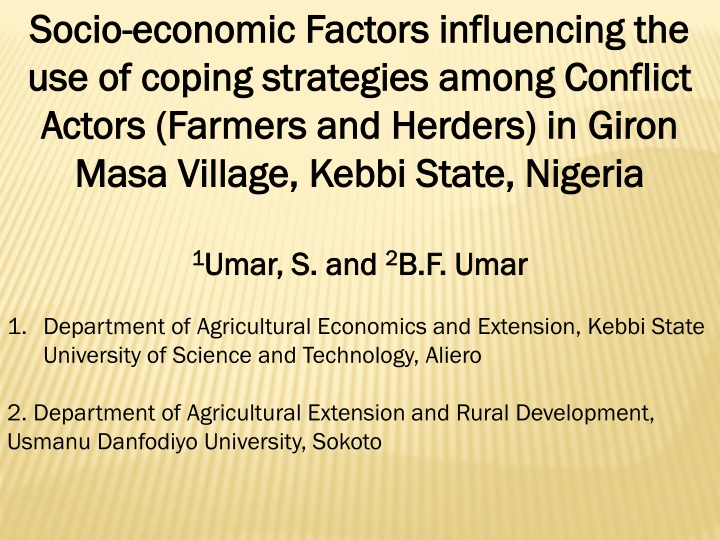
Factors Influencing Coping Strategies Among Conflict Actors in Giron Masa Village, Nigeria
Explore the socio-economic factors influencing coping strategies among farmers and herders in Giron Masa Village, Nigeria. The study delves into how age, income, family size, and farming experience impact the use of coping strategies post-conflict.
Uploaded on | 2 Views
Download Presentation

Please find below an Image/Link to download the presentation.
The content on the website is provided AS IS for your information and personal use only. It may not be sold, licensed, or shared on other websites without obtaining consent from the author. If you encounter any issues during the download, it is possible that the publisher has removed the file from their server.
You are allowed to download the files provided on this website for personal or commercial use, subject to the condition that they are used lawfully. All files are the property of their respective owners.
The content on the website is provided AS IS for your information and personal use only. It may not be sold, licensed, or shared on other websites without obtaining consent from the author.
E N D
Presentation Transcript
Socio Socio- -economic Factors influencing the economic Factors influencing the use of coping strategies among Conflict use of coping strategies among Conflict Actors (Farmers and Herders) in Actors (Farmers and Herders) in Giron Masa Masa Village, Village, Kebbi Kebbi State, Nigeria Giron State, Nigeria 1 1Umar, S. and Umar, S. and 2 2B.F. B.F. Umar Umar 1. Department of Agricultural Economics and Extension, Kebbi State University of Science and Technology, Aliero 2. Department of Agricultural Extension and Rural Development, Usmanu Danfodiyo University, Sokoto
Abstract Abstract - This study was conducted at Giron Masa village, located 30km from Yauri Town. The study determines the socio-economic factors influencing the use of coping strategies among farmers and herders during post-conflict situation. simple random sampling was employed to select one hundred respondents (50 farmers and 50 herders) from the study area. Logistic regression analysis (lr) was used to ascertain the socioeconomic variables that influenced the use of the coping strategies. The results of the study shows that age, income, family size and farming experience were individually significant and thus influenced the use of POCS by farmers. annual income and production system influenced the use of POCS by herders. age, farm size and farming experience were found to be individually significant in influencing the use of EOCS among farmers. specifically, years of occupation experience among the herders increased the use of emotion oriented coping strategies among herders. The use of SSCS among farmers was influenced by educational level; farm size and farming experience, while the variables are not collectively significant in influencing the use of SSCS among the herders. the research recommends a need to adopt the strategy of community coping to cope with stress.
I. INTRODUCTION Conflicts actors employ coping strategies in order to protect their psychological intactness. Effective strategies should enhance their psychological adaptation despite the traumatic stress. Research has not, however, provided a generally valid differentiation between effective and ineffective coping strategies. Some evidence shows that problem-focused and active coping correlates negatively, and emotion-focused coping correlates positively, emotional and behavioral problems. Yet others have not found beneficial effects of problem-focused and active coping in predicting psychological adjustment. Similarly, the findings on the role of avoidance versus approach coping in enhancing psychological adjustment are somewhat mixed. Some researchers obtained evidence that avoidance coping strategies, especially denial and distraction, are associated with poor psychological and social adjustment, while others maintain that coping effectiveness depends on the nature of stress.
II. METHODOLOGY The study was conducted at Giron Masa village. The reserve lies between latitude 11 061,483 N and longitude 04 42 , 356 E. The people of Giron Masa village are predominantly farmers and herders. Interview schedules were used to collect relevant data. Simple random sampling was employed to select One hundred (100) respondents (50 farmers and 50 herders). Logistic regression analysis (LR) was used to ascertain the socioeconomic variables that influenced the use of the 3 categories of coping strategies. Linear regression models provide a popular device for organizing data analysis in which researchers focus on the explanation of a dependent variable, Y, as a function of multiple independent variables, from X1 to XK. Logistic regression analysis examines the influence of various factors on a dichotomous outcome by estimating the probability of the event s occurrence.
The use of the log odds ratio in logistic regression provides a more simplistic description of the probabilistic relationship of the variables and the outcome in comparison to a linear regression by which linear relationships and more rich information can be drawn. It examines the relationship between one or more independent variables and the log odds of the dichotomous outcome by calculating changes in the log odds of the dependent variable itself. There are two models of logistic regression to include binomial/binary logistic regression and multinomiallogistic regression. Binomial/binary logistic regression is typically used when the dependent variable is dichotomous and the independent variables are either continuous or categorical variables. When the dependent variable is not dichotomous and is comprised of more than two cases, a multinomial logistic regression can be employed. At degree of freedom 10, the critical LR statistic (R ) is 18.037 at 0.05 probability level. Calculated LR statistic must be higher than 18.0370 for logistic regression to be statistically significant at 0.05 probability level.
RESULTS OF THE STUDY The Logistic regression analyses of socioeconomic variables influencing the use of each of the farmers and herders were presented in Tables I-III.
TABLE I: DISTRIBUTION OF CONFLICT ACTORS (FARMERS AND HERDERS) ACCORDING TO SOCIO-ECONOMIC FACTORS INFLUENCING THE USE OF PROBLEM-ORIENTED COPING STRATEGIES Independent Variables Coefficient Standard Error P R Remarks Age Farmers Herders Gender Farmers Herders Education level 0.63 0.27 0.26 0.33 0.009 0.22 0.793 0.582 * 0.08 0.04 0.03 0.001 0.62 0.46 0.795 0.763 Farmers Herders Annual income Farmers Herders Household size Farmers Herders Production system Farmers Herders Size of enterprise Farmers Herders Production motive Farmers Herders Occupation experience Farmers Herders Tenure arrangement Farmers Herders Constant Farmers 0.008 0.004 0.015 0.013 0.66 0.52 0.874 0.648 2.1x10 6 0.189 5.62x10-7 0.032 1 0.026 0.023 0.722 0.634 * * 0.34 -0.012 0.019 0.01 0.027 0.44 0.618 0.803 * 0.008 0.046 0.003 0.025 0.118 0.04 0.909 0.712 * 6.65x10-6 0.006 2.5x10-6 0.022 0.25 0.19 0.902 0.811 0.032 3.39x10-6 0.233 5.2x10-6 0.69 0.61 o.911 0.762 -0.049 0.051 0.021 0.011 0.0061 0.721 0.831 0.813 * -0.008 -7.12x10-4 0.22 0.496 0.571 0.933 0.912 2.36x10-4 -0.057 0.349 0.714 Herders -0.073 0.543 0.816
Table I continued * Significant at p=0.05 LR statistic (10 df): Farmers= 23.244; Herders= 20.623 Probability (LR stat): Farmers= 0.0154; Herders= 0.0141 McFadden R (collective): Farmers= 0.4523; Herders= 0.4159
TABLE II: DISTRIBUTION OF CONFLICT ACTORS (FARMERS AND HERDERS) ACCORDING TO SOCIO-ECONOMIC FACTORS INFLUENCING THE USE OF EMOTION-ORIENTED COPING STRATEGIES Independent Variables Age Farmers Herders Gender Farmers Herders Educational level Farmers Herders Annual income Farmers Herders Household size Farmers Herders Size of enterprise Farmers Herders Production system Farmers Herders Production motive Farmers Herders Occupation experience Farmers Herders Tenure arrangement Farmers Herders Constant Farmers Herders Coefficient Standard Error P R Remarks -0.46 -0.45 0.212 0.031 0.031 0.003 0.524 0.913 * * 0.09 0.04 0.25 0.21 0.45 0.19 0.812 0.922 0.045 0.032 0.012 0.001 0.26 0.32 0.786 0.904 6.2x10-7 2.20x10-6 2.38x10-6 6.21x10-6 0.39 0.17 0.824 0.844 0.22 0.06 0.04 0.02 0.26 0.23 0.861 0.36 2.60x10-6 0.053 9.52x10 5 0.028 0.045 0.74 0.618 0.624 * 0.005 9.1x10-7 0.326 2.4x10-6 0.52 0.66 0.861 0.861 0.050 0.045 0.031 0.003 0.81 0.32 0.901 0.925 -0.043 -0.037 0.012 0.015 0.043 0.027 0.775 0.832 * * 0.001 0.015 0.026 0.242 0.83 0.47 0.914 0.907 -0.057 -0.561 0.488 0.323 0.847 0.79
Table II continued * Significant at p=0.05 LR statistic (10 df): Farmers= 20.422; Herders= 21.624 Probability (LR stat): Farmers= 0.0024; Herders= 0.034; McFadden R (collective): Farmers= 0.3126; Herders= 0.6412;
TABLE III: DISTRIBUTION OF CONFLICT ACTORS ACCORDING TO SOCIOECO TABLE III: DISTRIBUTION OF CONFLICT ACTORS ACCORDING TO SOCIOECONOMIC FACTORS INFLUENCING THE USE OF SOCIAL SUPPORT SUPPORT COPING STRATEGIES COPING STRATEGIES NOMIC FACTORS INFLUENCING THE USE OF SOCIAL Independent Variables Age Coefficient Standard Error P R Remarks Farmers 0.33 0.012 0.363 0.810 Herders 0.25 0.015 0.82 0.611 Gender Farmers 0.212 0.20 0.42 0.834 Herders 0.019 0.01 0.36 0,807 Educational level 2.17x10-6 0.021 9.66x10 1 0.02x10 1 Farmers Herders Annual income Farmers Herders Household size Farmers Herders Size of enterprise Farmers Herders Production system Farmers Herders Production motive Farmers Herders Occupation experience Farmers Herders Tenure arrangement Farmers 0.032 0.221 0.665 0.418 * -6.5x10-6 0.008 2.25x10 1 0.03 0.46 0.21 0.783 0.861 0.462 0.023 0.025 0.253 0.69 0.46 0.902 0.795 -0.005 0.044 0.234 0.041 0.026 0.77 0.614 0.811 * 0.033 2.7x10 7 0.028 9.3x10 7 0.87 0.43 0.911 0.843 0.019 -0.015 0.015 0.22 0.62 0.28 0.872 0.714 0.327 0.003 0.026 0.015 0.009 0.610 0.863 0.772 * -0.031 0.014 0.21 0.913
Table III continued * Significant at p=0.05 LR statistic (10 df): Farmers= 19.213; Herders= 17.243 Probability (LR stat): Farmers= 0.0028; Herders= 0.0613 McFadden R (collective): Farmers= 0.4522; Herders= 0.342
CONCLUSION This research has attempted to broaden an understanding of various coping employed by farmers and herders during post-conflict situation to restore psychological intactness. It was observed that conflict actors attempt to relieve stress by solving the problem at hand or regulate their emotional responses, or by avoiding thinking about the event all together. The study also indicated that some of the coping strategies most often employed by the conflict actors do not adequately favor production systems of the conflict actors. For example, some conflict actors have the competence to ask for social support from their relatives or friends, but the response depends on certain factors such as prior relationship and the kind of resources available within the social support network.
RECOMMENDATIONS 1. The study recommends a need of forming common goals among the conflict actors as an initial stage in the proactive coping process. 2. Farmers and herders must form cooperatives and mobilize resources to address unforeseen potential stressors along the way. 3. Educational intervention should be encouraged by governmental and non- governmental organizations. 4. Government at all levels should encourage religious and community leaders to sensitize the conflict actors on effective coping mechanisms.

